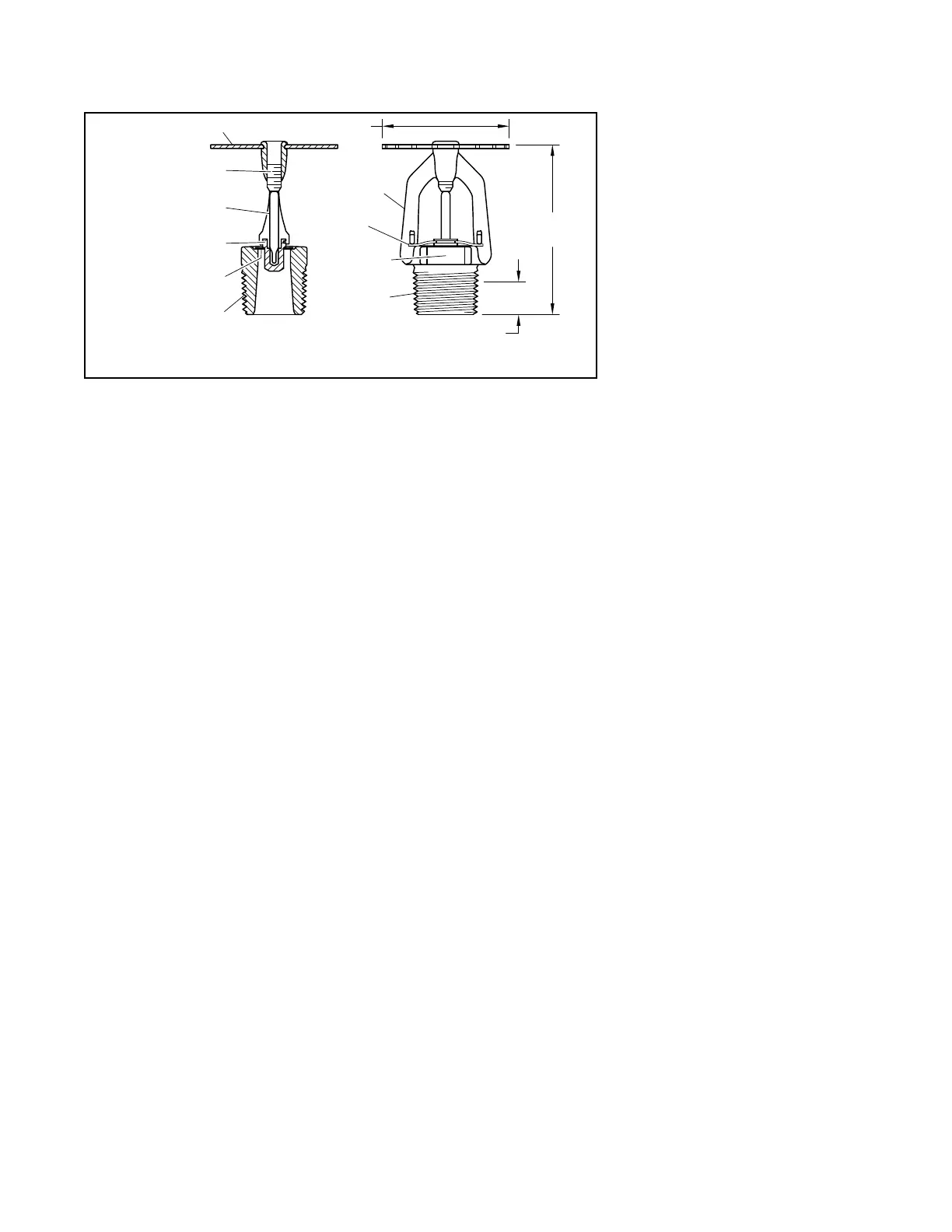TFP633
Page 2 of 8
Operation
The glass bulb contains a uid that
expands when exposed to heat. When
the rated temperature is reached, the
uid expands sufciently to shatter the
glass bulb allowing the sprinkler to acti-
vate and ow water.
Design
Criteria
Design criteria is provided as follows:
• 200°F (93°C), Model CC3 Combusti-
ble Concealed Sprinklers with CPVC
pipe and horizontal slope above
sprinklers not exceeding 2:12, see
Area of Use (CPVC Pipe)
• 200°F (93°C), Model CC3 Combusti-
ble Concealed Sprinklers with steel
pipe and horizontal slope above
sprinklers not exceeding 2:12, see
Area of Use (Steel Pipe)
• For the installation of Model CC3
Combustible Concealed Sprin-
klers installed with bafes at 2000
ft² (186 m²), the design of the sys-
tem should be 6 sprinklers or 1000 ft²
(93 m²), whichever is greater.
• For the installation of 5.6K Model
CC3 Combustible Concealed Sprin-
klers installed without the use of
draft curtains for unobstructed solid
wood truss construction on edge
or on face or unobstructed bar joist
construction, the design of the sys-
tem should be 9 sprinklers or 1000 ft²
(93 m²), whichever is greater.
Design Criteria,
CPVC Pipe
Area of Use (CPVC Pipe)
Horizontal (slope not exceeding 2:12)
combustible concealed spaces of:
• Unobstructed wood truss construc-
tion or unobstructed bar joist con-
struction, see Figure 2
• Non-combustible, insulation-filled
solid wood or composite wood joist
construction, see Figure 3
NOTE: In order to be considered
“non-combustible insulation-filled
solid wood or composite wood joist
construction,” the insulation (includ-
ing insulation provided with a combus-
tible vapor barrier), must completely fill
the pockets between the joists to the
bottom of the joists, and the insulation
must be secured in place with metal
wire netting. The metal wire netting is
intended to hold the insulation in place
should the insulation become wetted
by the operation of the Model CC3
Sprinklers in the event of a fire.
Concealed Space Area (CPVC Pipe)
The area of the concealed space is not
limited.
The 4.2K sprinkler is UL listed for a
1000 ft² (93 m²) draft curtain area as
shown in Figures 2 and 3.
The 5.6K sprinkler is UL Listed for a
2000 ft² (186 m²) draft curtain area as
shown in Figure 3. In addition, it may be
used without draft curtains as shown in
Figure 2 for unobstructed wood truss
construction, on edge or on face, or for
unobstructed bar joist construction.
This draft curtain shall be at least 1/3
the depth of the concealed space or 8
in. (200 mm), whichever is greater, and
be constructed using a material that
will not allow heat to escape through
or above the draft curtain.
For information about the use of anti-
freeze see the Technical Data section.
Concealed Space Size (CPVC Pipe)
The depth of the concealed space is
60 in. (1524 mm) maximum to 6 in. (152
mm) minimum.
System Type (CPVC Pipe)
Light hazard, wet pipe system
Maximum Distance Between
Model CC3 Sprinklers (CPVC Pipe)
TY2199 4.2K. . . . . . . . . . . . . . .14 ft (4,3 m)
TY3199 5.6K. . . . . . . . . . . . . . 16 ft (4,9 m)
Maximum Coverage Area
(CPVC Pipe)
TY2199 4.2K. . . . . . . . . . . 196 ft² (18,2 m²)
TY3199 5.6K. . . . . . . . . . . 256 ft² (23,8 m²)
Minimum Distance Between
Model CC3 Sprinklers (CPVC Pipe)
Minimum sprinkler spacing is 7 ft
(2,1 m)
NOTE: Minimum spacing does not
apply to any additional sprinklers
required for protection of CPVC pipe
that is offset over an obstruction.
Deflector Position (CPVC Pipe)
• 1-1/2 in. to 4 in. (40 to 100 mm) below
upper deck for wood truss construc-
tion or bar joist construction, see Fig-
ure 2
• 1-1/2 in. to 4 in. (40 to 100 mm) below
solid wood or composite wood joists,
see Figure 3
Minimum Distance Away From
Trusses (CPVC Pipe)
4-1/2 in. (114 mm)
Remote Area (CPVC Pipe)
The remote area is 1000 ft² (93 m²)
The remote area for unobstructed
solid wood truss construction or unob-
structed bar joist construction without
the use of draft curtains is 9 sprinklers
or 1000 ft² (93 m²), whichever is greater.
NOTE: The remote area does not
include any additional sprinklers
required for protection of CPVC pipe
that is offset over an obstruction.
Required Minimum Density
(CPVC Pipe)
0.10 gpm/ft² (4,1 mm/min)
Minimum Operating Pressure
(CPVC Pipe)
7 psi (0,48 bar)
Obstructions (CPVC Pipe)
See Figure 8 in this data sheet for
obstructions rules.
Use of UL Listed BLAZEMASTER
CPVC Pipe with Model CC3
Sprinklers
BLAZEMASTER CPVC product may
be used in concealed spaces requir-
ing automatic sprinklers, when used
in conjunction with Model CC3 Sprin-
klers. In order to use the BLAZEMAS-
TER CPVC product for wood truss or
bar joist construction, the horizon-
tal run of pipe must be a maximum
of 6 in. (150 mm) above the ceiling or
noncombustible ceiling insulation,
or 1/3 the depth of concealed space
(as measured from the top surface of
the ceiling to the bottom of the deck
-
-
-
-
-
-
-
WRENCH
FLATS
SPRINKLER
FRAME
ARMS
2-1/4"
Frame
Button
Sealing
Assembly
Deector
Bulb
Compression
Screw
Ejection
Spring
2
1
3
4
5
1/2" NPT
7
7/16" (11,1 mm) NOMINAL MAKE-IN
FIGURE 1
MODEL CC3 SPRINKLER
